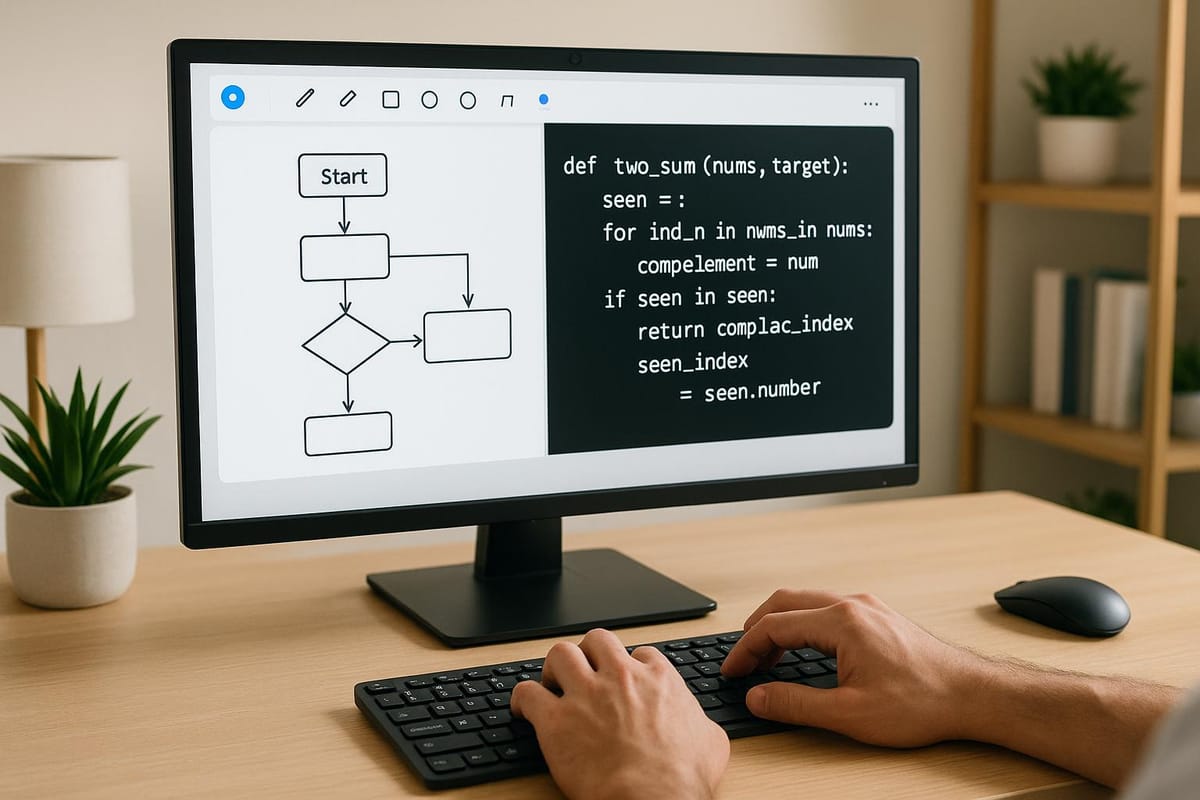How To Use Virtual Whiteboards for Coding Interviews
Master virtual whiteboards for coding interviews with essential tips on tools, preparation, and effective communication strategies.

Virtual whiteboards are essential for remote coding interviews. They help you write code, draw diagrams, and collaborate with interviewers in real time. Here’s how to get started:
- Why Use Them: They offer features like syntax highlighting, real-time collaboration, and debugging tools.
- Who Should Learn This: New grads, career changers, experienced developers, and international candidates.
- Prep Tips:
- Practice tools like zooming, panning, and formatting code.
- Set up a distraction-free workspace with good lighting, a stable internet connection, and quality audio equipment.
- Test your tools and connection before the interview.
- During the Interview:
- Explain your thought process clearly.
- Follow a structured problem-solving approach: clarify, plan, design, code, and test.
- Use whiteboard features like color coding and diagrams to stay organized.
Popular Platforms:
Platforms like CoderPad, Miro, and CodeSignal combine coding and collaboration tools for smooth interviews. Choose one based on your needs, like system design or algorithm-focused tasks.
| Platform | Best For | Features |
|---|---|---|
| CoderPad | Coding and debugging | Real-time code execution, encryption |
| Miro | System design and planning | Templates, infinite canvas, icons |
| CodeSignal | Technical assessments | IDE-whiteboard toggle, flowcharts |
Virtual Whiteboard Interviews | Episode # 40 | Data-Driven ...
Getting Ready for Your Interview
Set up your workspace and tools to effectively demonstrate your coding abilities.
Getting Comfortable With Your Tools
- Practice using keyboard shortcuts and mouse or tablet input for drawing and typing.
- Pay attention to proper code formatting, including indentation and structure.
- Familiarize yourself with collaboration tools for sharing control and making real-time edits.
- Learn to use view controls like zooming, panning, and screen layouts.
Spend 2–3 hours practicing to build muscle memory and reduce any technical hiccups during the interview.
Preparing Your Workspace
Create a focused, distraction-free environment to support your performance.
| Component | Recommendation | Reason |
|---|---|---|
| Internet Connection | At least 10 Mbps upload/download | Ensures smooth screen sharing and collaboration. |
| Lighting | Diffused, front-facing light | Keeps your face clearly visible. |
| Background | Plain or neatly organized | Projects a professional image. |
| Audio Equipment | External mic or quality headset | Ensures clear communication. |
| Secondary Monitor | 1920x1080 resolution or higher | Provides extra space for documentation. |
Pre-Interview Checklist
Run through these checks 30 minutes before your interview:
- Test Your Connection: Run a speed test to confirm your internet is stable.
- Check Audio and Video: Ensure your microphone and camera are properly set up.
- Log Into the Platform: Verify your credentials and update any necessary software.
- Test Drawing Tools: Make sure your drawing tools are responsive.
- Check Your Code Editor: Confirm syntax highlighting and auto-completion are working.
Have a backup device, like a tablet or second laptop, ready in case of technical issues. Keep your phone charged and set up as a potential hotspot in case your primary internet connection goes down.
Tips for Virtual Coding Sessions
Speaking with Interviewers
Clear communication is key in virtual coding interviews. Make sure to explain your thought process and confirm your understanding of the problem. For example:
"You're asking for a function that identifies all anagrams in a list, optimized for O(n) time complexity, correct?"
As you code, talk through your decisions to keep the interviewer in the loop:
"I'm using a hashmap here because it provides O(1) lookup time, which is necessary for detecting duplicates efficiently."
Problem-Solving Steps
Tackling coding problems is easier when you follow a structured approach. Here's a helpful framework:
| Step | Action | Example |
|---|---|---|
| Clarify | Restate the problem and constraints | "This involves graph traversal with cycle detection." |
| Plan | Outline your approach and tools | Select data structures and sketch the solution flow. |
| Design | Visualize the solution | Draw diagrams (e.g., binary tree for BFS). |
| Code | Write clean, readable code | Stick to conventions like Python's PEP8. |
| Test | Handle edge cases | Test scenarios like empty inputs or boundaries. |
This framework pairs well with the whiteboard tools discussed below.
Using Online Tools
Online whiteboard tools can enhance your problem-solving process by helping you stay organized and focused.
Visual Organization
- Use color coding: blue for variables, green for functions.
- Keep consistent indentation and spacing in your code.
- Use zoom and pan controls to center your active work area.
Time Management
Divide your time wisely to ensure you cover all steps:
- 5 minutes: Clarify the problem.
- 10 minutes: Plan and create diagrams.
- 15 minutes: Write and implement the code.
- 5 minutes: Test and refine your solution.
Maintain a steady pace to avoid getting stuck.
Handling Ambiguity
Create a dedicated "Assumptions" section to document:
- Input constraints (e.g., "The array will always contain integers").
- Edge cases you plan to address.
- Performance goals (e.g., "The solution should run in O(n) time complexity").
This approach ensures you stay on track and address any uncertainties effectively.
Virtual Whiteboard Platform Guide
This guide focuses on virtual whiteboard platforms tailored for coding interviews, combining coding tools and visual aids to make technical interviews more efficient and effective.
Platform Features Overview
When choosing a virtual whiteboard for coding interviews, here are some top platforms along with their standout features:
| Platform | Core Features | Best Use Cases | Notable Tools |
|---|---|---|---|
| CoderPad | - Real-time code execution integrated with whiteboard - Private note-taking - Image upload for UI mockups - SOC 2-compliant encryption |
Algorithm visualization and code implementation | Code-whiteboard sync |
| Miro | - Pre-made interview templates - AWS/Azure architecture icons - AI-powered component clustering - Infinite canvas |
System design interviews and architectural planning | Smart diagrams |
| CodeSignal | - Toggle between IDE and whiteboard - Shape libraries - Auto-expiring interview links |
Technical assessments with visual elements | Pre-built flowchart tools |
These platforms expand on basic whiteboard practices, offering tools that simplify technical interviews and improve communication.
Why These Platforms Make a Difference
Platforms like Miro and CoderPad provide specific advantages depending on the interview type. For instance:
- Miro: Its template library and AWS/Azure icons can cut system design prep time by 40% compared to older methods.
- CoderPad: By combining coding and whiteboard tools in one environment, it reduces context switching, increasing candidate satisfaction by 25% during interviews.
These features not only save time but also help candidates and interviewers focus on problem-solving and clear communication.
Tips for Better Performance
To get the most out of these platforms during interviews:
- Use the Chrome browser with hardware acceleration turned on.
- Close unnecessary background apps to avoid performance issues.
- Familiarize yourself with the platform's navigation and tools beforehand.
- Keep the platform software updated to ensure smooth functionality.
Security Features
Maintaining security is essential during virtual interviews. These platforms ensure integrity through:
- Encrypted sessions and temporary access links.
- Permission controls to manage user access securely.
- Audit logs to monitor activities during the interview.
As these tools continue to evolve, AI-powered features like automatic complexity analysis and architecture suggestions are being added to improve technical discussions even further.
Extra Help for Job Seekers
Save time and sharpen your skills for virtual whiteboard interviews with focused support.
Job Application Help
Let scale.jobs handle the heavy lifting of job applications while you concentrate on improving your coding and whiteboard skills. Their service delivers real results:
- Cuts job search time from 5 months to just 1–3 months
- Boasts a 93% success rate in landing full-time roles within 3 months
"Applying for jobs every day has been super daunting. But now with scale.jobs, one can apply to hundreds of jobs per day as well as focus on prep for interviews." - Sona Tambe
By automating routine applications, scale.jobs allows you to dedicate more time to technical prep:
| Benefit | Impact |
|---|---|
| Time Savings | 40% reduction in job search time |
| Focus | More time for interview preparation |
| Application Volume | Hundreds of targeted applications daily |
| Success Rate | 70% of users secure jobs within 30 days |
Free Job Search Tools
Scale.jobs also provides free tools to enhance your interview preparation:
Resume ATS Checker
Ensures your technical resume is keyword-optimized and formatted to pass applicant tracking systems.
Interview Questions Predictor
Assists you in:
- Anticipating common technical questions
- Practicing answers and improving coding skills
Additional Tools for Support
- Cover Letter Generator: Creates tailored cover letters for specific roles
- Salary Predictor: Helps you set realistic compensation expectations
- Portfolio Website Generator: Displays your coding projects in a polished, professional way
"Scale.jobs has been an excellent help in applying for a high volume of jobs, which otherwise would be very time-consuming... a high-volume approach helped me get a few interview calls which I wasn't getting earlier." - Shobhit Datta
These tools simplify the job search process, giving you more time to focus on coding practice and whiteboard prep - key advantages in technical interviews.
Next Steps
Combine your whiteboard practice with a focused job application strategy to improve your interview outcomes. Building on your preparation and practice, here’s how you can further sharpen your skills.
- Test your virtual whiteboard setup every day to ensure it's working smoothly.
- Hold mock interviews with screen sharing and record them for self-assessment.
- Watch your recorded sessions to identify areas for improvement and refine your approach.
Preparation Timeline
This timeline balances technical prep with your job search efforts:
| Timeframe | Key Focus Areas |
|---|---|
| Week 1-2 | Get comfortable with virtual whiteboard tools and setup. |
| Week 3-4 | Solve coding problems while clearly explaining your thought process. |
| Week 5-6 | Conduct mock interviews using screen sharing. |
| Ongoing | Continue dedicating time to technical preparation. |
Excelling in virtual coding interviews requires a mix of technical skills and familiarity with the tools. Streamlining your job search allows you to channel your efforts into mastering these areas, giving you a better shot at landing your ideal job.
FAQs
How can I use virtual whiteboards effectively during a coding interview?
Using virtual whiteboards effectively during coding interviews can help you clearly communicate your thought process and problem-solving approach. Start by ensuring your virtual whiteboard tool is set up and tested before the interview to avoid technical issues. Familiarize yourself with its basic features, like drawing, typing, and erasing, to save time during the session.
When solving problems, use the whiteboard to visually break down the question, write out pseudocode, and highlight key steps in your solution. Speak aloud as you work, explaining your logic and decisions to the interviewer. This not only showcases your technical skills but also demonstrates your ability to communicate complex ideas clearly.
If you're preparing for coding interviews, services like scale.jobs can help you focus on honing these skills by handling time-consuming job application tasks for you. This allows you to dedicate more time to practicing and improving your interview performance.
What features should I consider when selecting a virtual whiteboard for coding interviews?
When choosing a virtual whiteboard for coding interviews, look for features that enhance collaboration and efficiency. Real-time collaboration is essential, allowing both you and the interviewer to interact seamlessly. Ensure the platform supports syntax highlighting for coding, as this can make your code easier to read and debug. Ease of use is also important - opt for a tool with an intuitive interface to avoid wasting time during the interview.
Additionally, check for cross-platform compatibility so you can use it on any device, and ensure reliable performance with minimal lag. Many platforms also offer features like drawing tools and text formatting, which can help you visually explain your thought process. Taking the time to test your chosen tool beforehand can help you feel confident and prepared for your interview.
How can I set up my virtual whiteboard for a smooth and successful coding interview?
To ensure your virtual whiteboard setup runs smoothly during a coding interview, start by testing your tools ahead of time. Confirm that your whiteboard platform is compatible with your device and browser, and check your internet connection for stability. Familiarize yourself with the whiteboard features, such as text input, drawing tools, and shortcuts, so you can use them efficiently during the interview.
Position your camera and microphone to ensure clear communication with the interviewer, and minimize background noise or distractions. It's also a good idea to have a backup plan, like an alternate device or platform, in case of technical difficulties. Preparing in advance will help you stay focused and confident during the interview.




